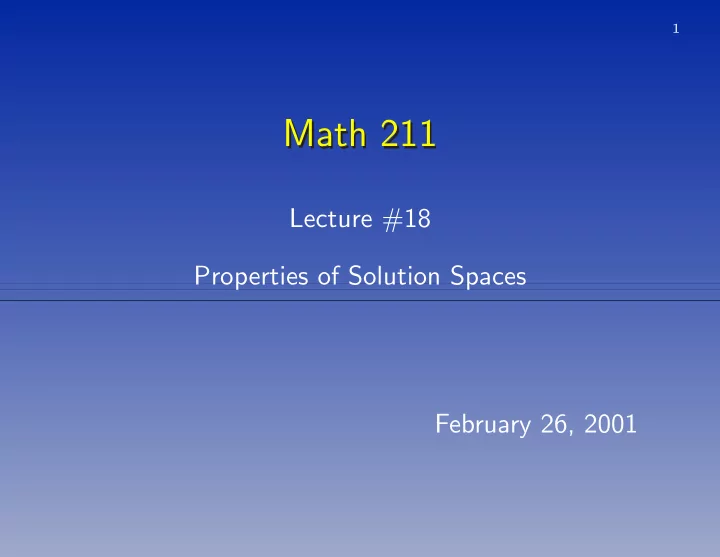

1 Math 211 Math 211 Lecture #18 Properties of Solution Spaces February 26, 2001
2 Method of Solution for A x = b Method of Solution for A x = b • Use the augmented matrix M = [ A, b ] . • Eliminate as many coefficients as possible. ⋄ Use row operations to reduce to row echelon form. • Write down the simplified system. • Backsolve. ⋄ Assign arbitrary values to the free variables. ⋄ Solve for the pivot variables. Return
3 Consistent Systems Consistent Systems • A system is consistent if it has solutions. ⋄ The solution set is not the empty set. • A system is consistent if and only if the simplified version (after elimination) is consistent. • This is true if and only if the last column (after elimination) does not contain a pivot. Return
4 Examples Examples − 3 6 0 2 − 9 A = − 2 4 0 b 1 = 3 b 2 = − 6 − 1 0 2 − 5 7 Method Consistent
5 Homogeneous Systems Homogeneous Systems Example − 5 − 4 − 2 − 5 − 4 − 2 0 A = − 6 − 6 − 2 − 6 − 6 − 2 0 ⇒ 30 27 11 30 27 11 0 • During elimination the column of zeros is unchanged. • It is unnecessary to augment a homogeneous system. Return
6 Structure of the Solution Set Structure of the Solution Set Let x p be a particular solution to Theorem: A x p = b . 1. If A x h = 0 then x = x p + x h also satisfies A x = b . 2. If A x = b , then there is a vector x h such that A x h = 0 and x = x p + x h . • Solution set for A x = b is known if we know one particular solution x p and the solution set for the homogeneous system A x h = 0 . Return
7 Square Matrices Square Matrices • There are special kinds: ⋄ Singular and nonsingular. ⋄ Invertible and noninvertible. • What do the terms mean? • What are the relations between them? Return
8 Singular and Nonsingular Matrices Singular and Nonsingular Matrices The n × n matrix A is nonsingular if the equation A x = b has a solution for any right hand side b . The n × n matrix A is nonsingular Proposition: if and only if the simplified matrix (after elimination) has only nonzero entries along the diagonal. • In reduced row echelon form we get I . Return
9 Examples Examples − 17 − 16 − 6 A = 18 18 6 6 3 3 − 17 − 16 − 6 A = 18 18 6 6 3 4 Singular
10 If the n × n matrix A is Proposition: nonsingular then the equation A x = b has a unique solution for any right hand side b . The n × n matrix A is singular if Proposition: and only if the homogeneous equation A x = 0 has a non-zero solution.
11 Invertible Matrices Invertible Matrices An n × n matrix A is invertible if there is an n × n matrix B such that AB = BA = I . The matrix B is called an inverse of A . • If B 1 and B 2 are both inverses of A , then B 1 = B 1 ( AB 2 ) = ( B 1 A ) B 2 = B 2 • The inverse of A is denoted by A − 1 . • Invertible ⇒ nonsingular . Return Outline
12 Computing the inverse A − 1 Computing the inverse A − 1 • Form the matrix [ A, I ] . • Do elimination until the matrix has the form [ I, B ] . • Then A − 1 = B . • A matrix is invertible if and only if it is nonsingular. Outline
13 Solution Set of a Homogeneous System Solution Set of a Homogeneous System Our goal is to understand such sets better. In particular we want to know: • What are the properties of these solution sets? • Is there a convenient way to describe them? Solution set
Recommend
More recommend